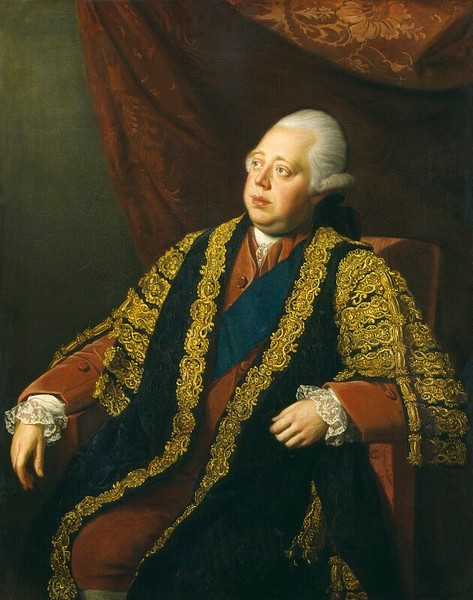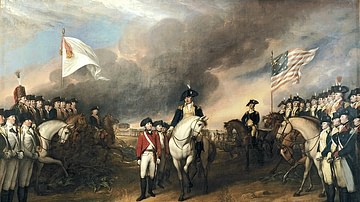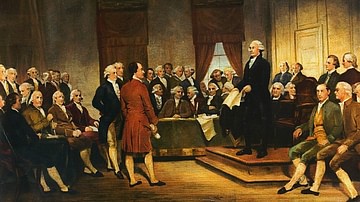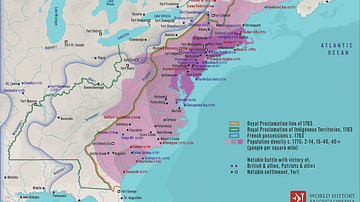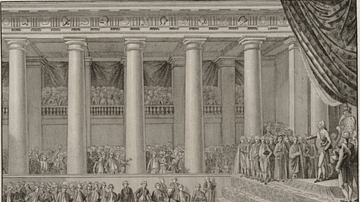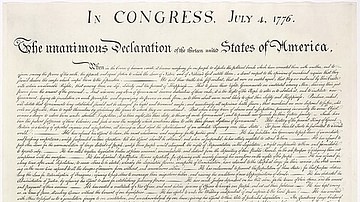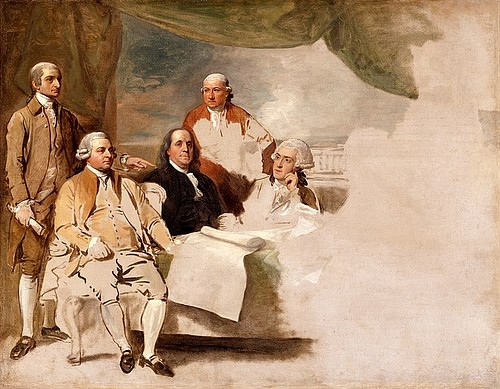
The Treaty of Paris, signed on 3 September 1783 by representatives from Great Britain and the United States, was the peace agreement that formally ended the American Revolutionary War (1775-1783) and recognized the United States as an independent nation. The treaty was considered generous to the United States, fixing its border at the Mississippi River and thereby doubling its territory.
Background: The World Turned Upside Down
On 19 October 1781, the battered British army marched out of Yorktown, Virginia. Dressed in resplendent new uniforms freshly issued for the occasion, the British soldiers passed between the French and American armies to throw their muskets onto a steadily growing pile of surrendered arms. Emotions were running high; some British soldiers wept as they laid down their weapons, while others haphazardly threw their muskets onto the pile in the hopes that they would smash. Lord Charles Cornwallis, commander of the surrendering British army, was not present at the ceremony, having pled illness. It was left to his second-in-command, General Charles O'Hara, to offer his sword to American General George Washington, who refused, instead motioning for O'Hara to give the sword to his own second-in-command, General Benjamin Lincoln. According to legend, as the ceremony took place, the military bands played a tune aptly titled "The World Turned Upside Down".
As this dramatic scene suggests, it was immediately apparent that the Siege of Yorktown marked an important turning point in the war. But in the direct aftermath of the siege, few could have anticipated just how significant it had been. Despite Cornwallis' surrender, the British army certainly had the military capacity to continue fighting, as they still possessed sizable military presences in New York City, Charleston, Canada, and the West Indies. Indeed, King George III of Great Britain (r. 1760-1820) and Prime Minister Lord Frederick North, had every intention of planning a campaign for the upcoming 1782 season. The king and his ministers knew that the fledgling United States was on the verge of failing. The Continental currency issued by Congress was worthless, and many of the underpaid soldiers of the Continental Army were close to mutiny. To top it all off, the treasury of the Kingdom of France was running dangerously low, leading the French to hint that they would have to exit the war if peace was not soon concluded. All King George III and Lord North had to do was prolong the war for a year or two more, and the American rebellion would collapse in on itself.
But unfortunately for the king and his ministers, the British people had long been experiencing war fatigue, and the defeat at Yorktown was the final straw. This attitude was reflected in Parliament when it reconvened after its Christmas recess in January 1782. While many in Parliament did not necessarily approve of an independent United States, they were more concerned about the negative impact that the war was having on British resources and international prestige, particularly after the conflict had taken on a global scale with the entry of France and Spain in 1778-79. Year after year, members of Parliament had listened to Lord North give excuses as to why British arms had failed in North America during the previous campaign season, before promising that a British victory loomed just over the horizon. Now, when news of Cornwallis' surrender reached London, they had finally had enough. In February 1782, colonial secretary Lord George Germain was forced out of the cabinet, with Lord Sandwich, First Lord of the Admiralty, losing his position soon after. The house of cards finally collapsed on 20 March, when Lord North resigned rather than face the indignity of being removed from office by a vote of no confidence. George III himself even considered abdicating the throne but was persuaded against it.
North was replaced as prime minister by Charles Watson-Wentworth, 2nd Marquess of Rockingham, whose political faction, known as the 'Rockingham Whigs', had opposed many of the policies of the North ministry including the war in North America. Supported by influential British politicians like Charles James Fox and Edmund Burke, Lord Rockingham immediately took steps to end the war upon coming to power; the king, who despised Rockingham – indeed, the two could not even be in the same room – could do nothing as the new ministry set about bringing seven years of war to an end. In April 1782, Rockingham sent a representative to Paris to begin informal peace talks. When Rockingham unexpectedly died the following July, the Earl of Shelburne became prime minister and took up the supervision of the negotiations.
Opening Discussions
The man that Rockingham had selected to represent Great Britain in Paris was Richard Oswald, a Scottish merchant who owned land in America and had made his fortune through the slave trade. Arriving in Paris in April 1782, Oswald was quickly introduced to Benjamin Franklin, the famous American polymath who had been serving as US minister to France for the last few years. The two men had some informal discussions regarding peace, but were unable to make any progress for several more months; Oswald's formal commission did not come in for some time yet, while Franklin had to wait for his fellow peace commissioners, selected by Congress, to arrive. These included John Adams, who was currently in Amsterdam finalizing a loan from Dutch bankers; John Jay, the US minister to Spain who had been frustrated in his attempts to get Spain to recognize the United States; and Henry Laurens, former president of the Continental Congress who had been captured in 1780 and now languished in the Tower of London. Oswald, who had done business with Laurens before the war, helped arrange his release from the Tower and secured his passage to France. Thomas Jefferson had also been appointed as one of the peace commissioners, but he had declined, citing personal reasons.
Serious talks finally began in September 1782, once Oswald had received his formal commission as emissary and Franklin had been joined by Jay and Laurens (Adams would not arrive until late October). But negotiations quickly stalled. Oswald had not been instructed to recognize the independence of the United States, something that the American commissioners insisted on before any further discussion. This stalemate greatly frustrated the French foreign minister, Comte de Vergennes, who was counting on a swift peace treaty; the war was putting an immense strain on France's treasury, and the recent defeat of a French fleet at the Battle of the Saintes (April 1782) weakened France's leverage in negotiations. Vergennes urged Franklin and the other commissioners to put aside the "point of independence" until the final treaty; in the meantime, the French foreign minister sent secret envoys to London to hint that France did not support all the Americans' demands and would be willing to consider other options (McCullough, 275). The issue was eventually resolved at the end of September when Oswald was finally authorized to recognize the United States as a sovereign nation.
Formal sessions resumed on 30 October 1782, with Adams now in attendance, and would continue for the next month. Henry Strachey, the British undersecretary of state, arrived to take part in the negotiations and make sure that Oswald adhered to his instructions. Strachey was described in Adams' journal as a man who "pushed and pressed every point", but even still, the British diplomats were less seasoned than the Americans; Franklin, Jay, and Adams had spent the last several years refining their diplomatic skills as they attended the courts of Europe trying to drum up support and aid for the American cause. Henry Laurens, for his part, did not contribute much to the discussions; his health had been failing since his imprisonment, and news of the death of his son, Colonel John Laurens, in an inconsequential skirmish the previous August caused him to withdraw even further.
Terms & Agreements
Once the British envoys had recognized the independence of the United States, there were several questions left to be settled. The most glaring of these questions was one of boundaries: where was the border of the United States to be drawn? While the British refused to cede Canada, as was Franklin's desire, they did agree to surrender all territory between the Appalachian Mountains and the Mississippi River, which more than doubled the size of the United States. All British-owned property within these boundaries was to be forfeited, and all US territories currently occupied by the British military would be returned without compensation. Additionally, both nations were granted access to the Mississippi River, and the Americans were granted all-important fishing rights off Newfoundland and the St. Lawrence River.

The question of Loyalists – those Americans who had sided with Britain during the war – proved more contentious. Henry Strachey argued that the Loyalists should be compensated for the property and wealth they had lost by supporting Britain; the American commissioners were quite unsympathetic to the plights of the Loyalists, who they considered traitors, and wanted to give them nothing. In the end, it was agreed that it would be left to the individual states to compensate Loyalists for property seized during the war, a gesture that both parties understood to be effectively meaningless. Finally, both sides would return any prisoners of war, and Britain would withdraw its soldiers from US soil "with all convenient speed" (Middlekauff, 594). After the negotiations, Strachey went to London with the proposed articles to seek approval from Lord Shelburne's government. He returned to Paris on 25 November, and after some last-minute revisions, the final draft of the Treaty of Paris was completed on 30 November 1782.
The finalized Treaty consisted of a preamble and ten articles; the articles are summarized below:
- His Britannic Majesty George III acknowledges the United States as a free and sovereign nation and relinquishes all claims to its government and territory.
- The boundaries of the United States are fixed below Canada to the north and at the Mississippi River to the west.
- The Americans are granted fishing rights in Newfoundland and in the St. Lawrence River, and they are also allowed to dry and cure fish in Nova Scotia, Magdalen Islands, and Labrador, so long as those places remain unsettled.
- Pre-war debts owed to one side shall still be paid by the other.
- Congress will recommend state governments to compensate Loyalists for properties confiscated during the war.
- The United States will not confiscate any more Loyalist lands from here on out.
- All prisoners of war are to be released, and the British are to remove their "armies, garrisons, and fleets" from the United States.
- Navigation of the Mississippi River will remain open to both Britain and the US.
- Territories captured during the war that were not specifically ceded in the treaty must be returned.
- The Treaty must be ratified within six months of its signing.
Signing the Treaty
Vergennes and the French ministers were initially incensed when they learned that a treaty had been drafted. They had been left out of the negotiations, which effectively meant that the US had made a separate peace without them. It was left to Franklin to soothe Vergennes' fury, telling him that peace had not yet been finalized and that this was only a preliminary agreement. Vergennes quickly came around and was forced to admit that the terms of the treaty were better than anything he had hoped for. On 20 January 1783, France and Spain signed their own preliminary treaties with Britain. France gained control of Tobago and some land around the Senegal River, but otherwise, Britain and France both agreed to give back all territories that had been captured since 1778. Spain gained possession of the Floridas and Menorca, in exchange for the Bahamas, which were ceded to Britain. Lastly, France and Spain agreed to abandon the Great Siege of Gibraltar, with Gibraltar remaining in British hands. Preliminary peace with the Dutch Republic did not come until 2 September 1783, when Britain agreed to return all Dutch possessions that it had captured in the East Indies.
Once all parties had agreed to their respective preliminary treaties, it was time to sign. On 3 September 1783, Franklin, Adams, and Jay affixed their signatures to the treaty, as did one British envoy, David Hartley, who had replaced Oswald. The treaty was sent on to Congress, which officially ratified it on 14 January 1784. After more than eight grueling years, the American Revolutionary War was finally over; celebrations were thrown across the United States while, in November 1783, the last British troops sailed out of New York City.
Aftermath
Most scholars agree that the terms of the Treaty of Paris were generous to the United States, whose western border was more than doubled. However, there were some points of contention that lingered long after the treaty was signed. As might have been expected, the states proved reluctant to compensate Loyalists for their confiscated property; many Loyalists filed for compensation in the years after the treaty, but few ever received any at all. Additionally, the failing paper currency of the United States – and the inability of the federal government to raise taxes under the Articles of Confederation – made it difficult for American debtors to pay back their British creditors, as was mandated in the treaty. Britain seized on this as an excuse to keep soldiers in several forts on American soil in the Great Lakes Region, from which they gave support to Native American nations hostile to the United States in the Northwest Indian War (1790-1795). It was not until the Jay Treaty of 1794 that these issues were resolved and commercial relations were reopened between Britain and the US. Peace, however, would not last, as Britain and the United States would once again go to war in the War of 1812.

